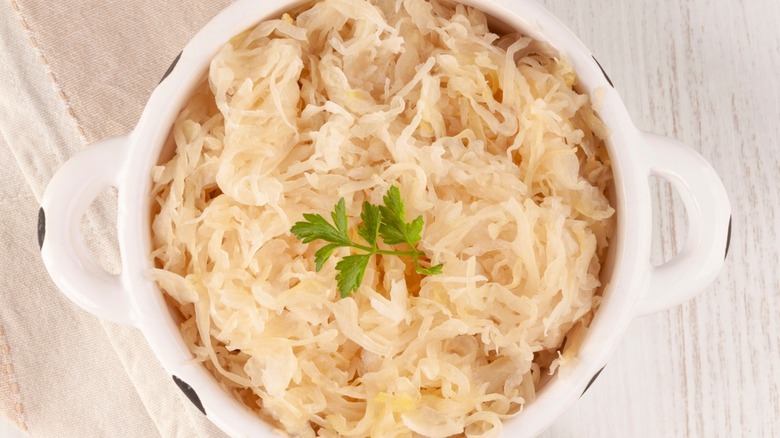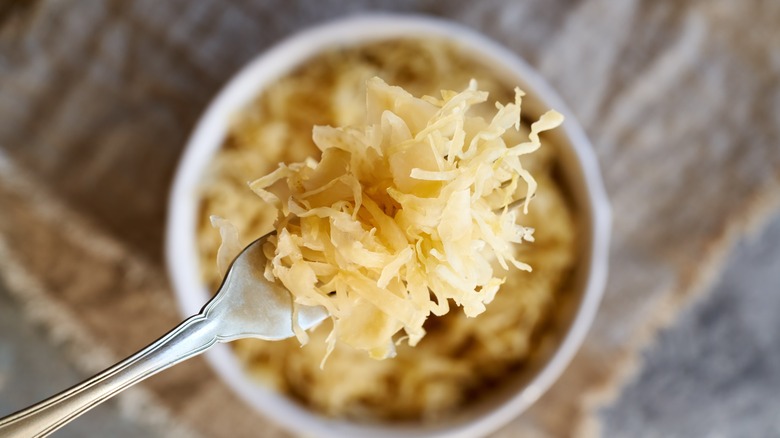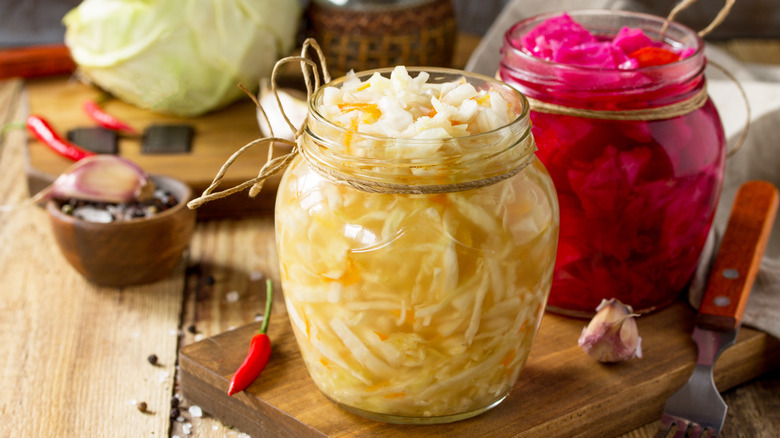How Sauerkraut Was Actually Brought To America
With its trademark fermented flavor and host of health benefits, sauerkraut is a staple in many cultures. It is wildly versatile and has many similarities to items like kimchi, but with a decidedly European spin. How and when was sauerkraut invented, though? What was the aim of turning cabbage into sauerkraut? And how did its invention influence American gastronomy?
What's Cooking America states that sauerkraut is "finely-chopped cabbage that is salted and then fermented in its own juice." It means "sour cabbage" in German. Sauerkraut is produced "by placing salt between layers of finely-shredded or chopped cabbage and then subjecting it to pressure, which bruises the cabbage and squeezes out its juices." From there, the cabbage begins to ferment, thereby turning into sauerkraut. The salt is "used to convert the natural sugars [in cabbage] into lactic acid," which then ferments the cabbage and results in the familiar tang of sauerkraut (via Delishably).
How sauerkraut came to America
A 1979 New York Times article notes that "the pungent, puckery vegetable, which we think of as essentially German," originally came from China to Europe by way of the Tartars. What's Cooking America writes that Chinese cooks were pickling cabbage in wine back in 200 B.C., and Make Sauerkraut states that sauerkraut was created in China during the construction of the Great Wall when cabbage was preserved throughout the winter by soaking it in rice wine. Later, the concept migrated to Europe, where the technique was slightly amended by packing the cabbage with salt instead of rice wine.
German and Central European immigrants brought sauerkraut to the U.S., mainly to the states of Pennsylvania and Ohio, where their communities became known as the Pennsylvania Dutch. The origins of a hot dog with sauerkraut are clear: German immigrants living in 1800s New York City sold sauerkraut with sausages and milk on push carts — which were the progenitors of the now iconic hot dog carts.
Make Sauerkraut notes that the word sauerkraut first appears in an American dictionary in the late 1700s and that it was actually instead called "liberty cabbage" during WWI so as to avoid the stigma or negative connotation of a word that was clearly German.
Why sauerkraut remains popular in America
German Foods acknowledges that sauerkraut has been a "staple in the German diet since the 1600s." However, while it once was relegated to being a tepid side dish, sauerkraut's incredible health benefits have helped cause a resurgence in its popularity in America. It's unquestionably a superfood.
Make Sauerkraut notes that sauerkraut has "live and active probiotics that act like your first line of defense against various harmful bacteria or toxins that might enter your body." Sauerkraut also contains digestive enzymes, high levels of vitamins, antioxidants, vitamin K2, and fiber. It's additionally very high in minerals and Delishably notes that it can also lower blood pressure and cholesterol. Modern Farmer states that it's particularly high in vitamin C due to the fermentation process. In fact, sauerkraut was used by sailors to fight off scurvy when they endured torturous months-long voyages across the sea.
From a flavor perspective, sauerkraut offers a fascinating, tart counterpoint to heavier, meatier, fattier foods. Sauerkraut helps to cut the inherent fattiness of meats, sauces, and heavier foods, lending a bright, acidic note to otherwise rich dishes and helping to balance them (via the New York Times).
Clearly, sauerkraut is so much more than just a milquetoast side dish, condiment, or topping. It is rich with history, flavor, and health benefits and should be regarded as such.


